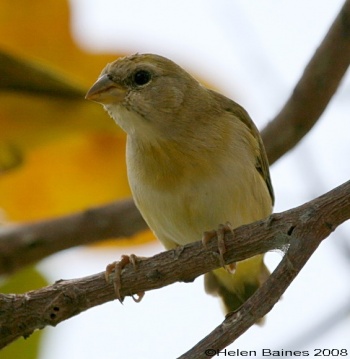(add reference) |
(edit references) |
||
| Line 6: | Line 6: | ||
11-12cm (4.25-4.75ins). | 11-12cm (4.25-4.75ins). | ||
*Male: Orange forehead extending to front of crown - can be very bright in some individuals; underparts yellow, sometimes with some olive streaking on breast and sides; tail and wings olive; eye dark, bill and legs flesh-colored. | *Male: Orange forehead extending to front of crown - can be very bright in some individuals; underparts yellow, sometimes with some olive streaking on breast and sides; tail and wings olive; eye dark, bill and legs flesh-colored. | ||
| − | *Female: upperparts grayish-brown, breast buffy, belly and vent lighter with some streaking. | + | *Female: upperparts grayish-brown, breast buffy, belly and vent lighter with some streaking.<sup>[[#References|2]]</sup> |
*Similar species: [[Saffron Finch]] | *Similar species: [[Saffron Finch]] | ||
| Line 13: | Line 13: | ||
==Taxonomy== | ==Taxonomy== | ||
| − | There are 3 subspecies: <sup>[[#References|1]]</sup> | + | There are 3 subspecies:<sup>[[#References|1]]</sup> |
*S. c. columbiana | *S. c. columbiana | ||
*S. c. goeldii | *S. c. goeldii | ||
| Line 22: | Line 22: | ||
==Behaviour== | ==Behaviour== | ||
| − | Forages on the ground for seeds and will fly up into trees or shrubs if disturbed. Pairs usually stay together in a breeding territory, but will join flocks with other finches, such as [[Saffron Finch]]es. | + | Forages on the ground for seeds and will fly up into trees or shrubs if disturbed. Pairs usually stay together in a breeding territory, but will join flocks with other finches, such as [[Saffron Finch]]es.<sup>[[#References|2]]</sup> |
==References== | ==References== | ||
# Avibase | # Avibase | ||
| − | Robin Restall et al, 2006. ''Birds of Northern South America, Vols 1 and 2.'' Yale University Press, Newhaven and London. ISBN: 978-0-300-10862-0 and 978-0-300-12415-6, respectively. | + | # Robin Restall et al, 2006. ''Birds of Northern South America, Vols 1 and 2.'' Yale University Press, Newhaven and London. ISBN: 978-0-300-10862-0 and 978-0-300-12415-6, respectively. |
==External Links== | ==External Links== | ||
*[http://www.xeno-canto.org/species.php?query=Sicalis+columbiana Range map] | *[http://www.xeno-canto.org/species.php?query=Sicalis+columbiana Range map] | ||
Revision as of 20:29, 17 June 2009
- Sicalis columbiana
Identification
11-12cm (4.25-4.75ins).
- Male: Orange forehead extending to front of crown - can be very bright in some individuals; underparts yellow, sometimes with some olive streaking on breast and sides; tail and wings olive; eye dark, bill and legs flesh-colored.
- Female: upperparts grayish-brown, breast buffy, belly and vent lighter with some streaking.2
- Similar species: Saffron Finch
Distribution
Orinoco Basin in east Colombia and Venezuela; Brazil along the Amazon River and in eastern Brazil, i.e. west Bahia. See external links below for a range map.
Taxonomy
There are 3 subspecies:1
- S. c. columbiana
- S. c. goeldii
- S. c. leopoldinae
Habitat
Tropical; open scrub near forest edges, pastures, grassy land near farms and ranches, always near water.
Behaviour
Forages on the ground for seeds and will fly up into trees or shrubs if disturbed. Pairs usually stay together in a breeding territory, but will join flocks with other finches, such as Saffron Finches.2
References
- Avibase
- Robin Restall et al, 2006. Birds of Northern South America, Vols 1 and 2. Yale University Press, Newhaven and London. ISBN: 978-0-300-10862-0 and 978-0-300-12415-6, respectively.





